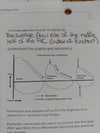Lab 11 Simulations Flashcards
(23 cards)
A classification of various lung diseases / disorders that includes asthma chronic bronchitis and emphysema
Chronic obstructive pulmonary disease (COPD)
What does expansion of the thoracic cage lead to
An increase in lung volume
What is the result of atmospheric pressure being equal to intrapleural pressure
(If lung were punctured )
Lungs would not inflate
What changes the volume of the thoracic cage
Skeletal muscles
especially diaphragm
Air flows into and out of the lungs down it’s _____ _____
Pressure gradient
Pressure of air in the atmosphere
(outside the body and lungs)
Atmospheric pressure
Pressure of air in the alveoli (air sacs) of the lungs example ( inside the body of the lungs)
Intra alveolar pressure
Pressure existing in the plural cavity between the parietal pleural lining and the plural cavity and the visceral pleural covering outside of the lungs
Intrapleural pressure
This is used to measure lung volumes and capacities
Spirometer
Air flow can be measured to create what (2 things)
1) air flow volume loops
2) diagnose lung diseases
This type of disorder results in a flow of air that is less than it should be
Obstructive lung disorders
This type of disorder have a normal flow of air but a low vital capacity and a low inspiratory and expiratory volumes
Restrictive lung disorders
Volume of air in each breath during regular breathing
Tidal volume
The additional volume of air that can be moved into the lungs above tidal volume
Inspiratory reserve volume
The additional volume of air that can be moved out of the lungs below tidal volume
Expiratory reserve volume
The total amount of movable air
Vital capacity
TV + IRV + ERV
The total amount of air forcefully exhaled from fully inflated lungs this is how vital capacity is measured
Forced vital capacity
The percentage of the forced vital capacity that is expired in one second
Forced expiratory volume 1
The average flow rate of the middle half of the forced vital capacity (index of function)
Forced expiratory flow 25-75
Analyzing this will confirm the diagnosis of an obstructive or restrictive lung disease
Flow volume loop
This test is used in conjunction with flow tests to differentiate obstructive and restrictive lung disease
Pulmonary volume tests
Is it possible for a patient to have both obstructive and restrictive disorders of the lung simultaneously
What would you expect in the lab data of a patient with both obstructive and restrictive disorders
1) Yes
2) reduced lung volume with reduced airflow

recognize these


